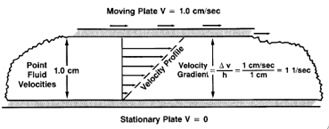Viscosity is a measure of a fluid’s resistance to flow. In drilling fluids, it plays a crucial role in determining the fluid’s ability to carry cuttings to the surface, lubricate the drill bit, and maintain wellbore stability.
viscosity can be measured using both a viscometer and a Marsh funnel, but the methods and results are different

- Shear stress is the amount of force needed to keep a fluid flowing in a certain way.
- In laminar flow (where the fluid flows in smooth layers, without mixing), this force comes from the friction between those layers (laminae) as they slide past each other.
In simple terms, shear stress measures the “push” required to overcome the internal friction within the fluid to maintain smooth, layered flow.
The mathematically definition of shear stress is :
This is expressed as lb/100 ft2 or as Dynes/cm2
Shear Rate : The shear rate is a measure of how quickly the velocity of a fluid changes from one layer to the next as it flows. Think of it like this:
- Imagine the fluid as a stack of thin layers (laminae).
- Some layers move faster than others, like a deck of cards being slid sideways.
- The shear rate tells us how much the speed changes between two neighboring layers for every unit of distance between them.
In oilfield units, the viscosity is measured in centipoise (cp).
For a Newtonian fluid, the relationship between shear stress (force applied) and shear rate (how fast the fluid flows) is directly proportional. The viscosity (resistance to flow) stays constant and is the only factor needed to describe how the fluid flows.
For non-Newtonian fluids (like most drilling fluids), the relationship between shear stress and shear rate is more complex and is described by the effective viscosity. However, the effective viscosity is not constant.
- At low shear rates (when the fluid is moving slowly), the effective viscosity is high.
- At high shear rates (when the fluid is moving quickly), the effective viscosity is low.
- This means the fluid becomes thinner (less viscous) as the shear rate increases. This behavior is called shear thinning.
Shear thinning is a very useful property for drilling fluids:
- At high shear rates (in the drill pipe and bit nozzles), the viscosity is lower, allowing the fluid to flow more easily.
- At low shear rates (in the annulus), the viscosity is higher, helping to lift and remove cuttings effectively.